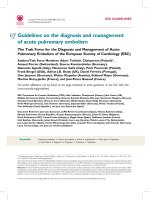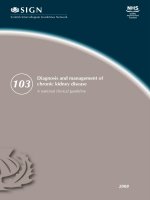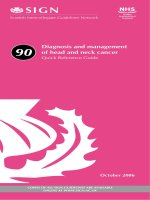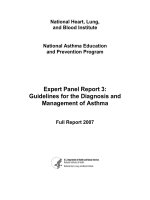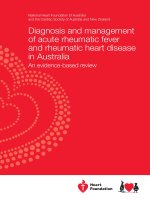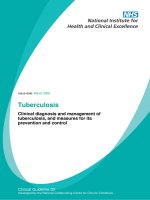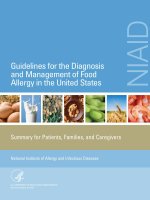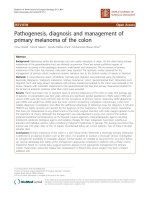Guidelines for the Diagnosis and Management of Food Allergy in the United States docx
Bạn đang xem bản rút gọn của tài liệu. Xem và tải ngay bản đầy đủ của tài liệu tại đây (363.37 KB, 36 trang )
NIAID
Guidelines for the Diagnosis
and Management of Food
Allergy in the United States
Summary for Patients, Families, and Caregivers
National Institute of Allergy and Infectious Diseases
U.S. DEPARTMENT OF HEALTH AND HUMAN SERVICES
National Institutes of Health
National Institute of Allergy and Infectious Diseases
Guidelines for the Diagnosis
and Management of Food
Allergy in the United States
Summary for Patients, Families, and Caregivers
U.S. DEPARTMENT OF HEALTH AND HUMAN SERVICES
National Institutes of Health
National Institute of Allergy and Infectious Diseases
NIH Publication No. 11-7699
May 2011
www.niaid.nih.gov
CONTENTS
Contents
4
Introduction
6
Food Allergy, Prevalence, and Associated Disorders
9
Diagnosis of Food Allergy
19
Management of Nonacute Allergic Reactions and
Prevention of Food Allergy
25
Diagnosis and Management of Anaphylaxis
Caused by Food
29
Sample Anaphylaxis Emergency Action Plan
30
Glossary*
NIAID I SUMMARY FOR PATIENTS, FAMILIES, AND CAREGIVERS
* Note: Words in blue throughout the text are defined in the glossary.
3
INTRODUCTION
Introduction
Most of us eat without a thought that something so essential to life might also
harm us. But for people who are allergic to one or more foods, every mouthful
can be a worry. Although allergic reactions to food can be mild, they also may
be severe, leading to a life-threatening allergic reaction called anaphylaxis.
The Guidelines for the Diagnosis and Management of Food Allergy in the
United States: Report of the NIAID-Sponsored Expert Panel were written to
provide healthcare professionals with the most up-to-date clinical advice on
how to care for their patients with food allergy.
NIAID I GUIDELINES FOR ThE DIAGNOSIS AND MANAGEMENT OF FOOD ALLERGY IN ThE UNITED STATES
HowweretheGuidelinesdeveloped?
4
The Guidelines are the culmination of a 2-year effort in which the
National Institute of Allergy and Infectious Diseases (NIAID), part of the
National Institutes of Health, worked with 34 professional organizations,
federal agencies, and patient advocacy groups. A panel of experts from a
variety of clinical backgrounds developed the Guidelines based on a review
and evaluation of recent scientific publications about food allergy.
The Guidelines are intended to help U.S. healthcare professionals make
appropriate decisions about patient care; however, it is vital that patients,
families, and caregivers understand what the Guidelines say about
managing food allergy.
What else you should know: The Guidelines are not an official regulatory
document of any government agency. They are intended as a resource to guide
clinical practice and to help develop educational materials for patients, their
families and caregivers, and the public. They do not override your doctor’s
responsibility to make decisions appropriate to your circumstances.
If you want to read more about how the Guidelines were developed, visit
NIAID’s food allergy guidelines Web site at />foodallergy/clinical.
INTRODUCTION
WhatdotheGuidelinestellyourdoctor?
The Guidelines include definitions of food allergy and related disorders,
recommendations on how to diagnose and manage food allergy, and ways to
diagnose and manage severe and life-threatening allergic reactions to food.
Whatdoesthisbooklettellyou?
This booklet summarizes the most important information from the Guidelines
and provides a starting point for patient-doctor conversations about food
allergy. We hope that this information will empower patients, families, and
caregivers with the knowledge they need to manage the disorder and, in turn,
experience a better quality of life.
There are 43 guidelines, and each includes the word “recommends” or
“suggests.” These words convey the strength of the guideline, defined as
follows:
• Recommend is used when the expert panel strongly recommended for
or against a particular course of action.
• Suggest is used when the expert panel recommended weakly for or
against a particular course of action. The reason for this was usually
the lack of strong evidence to support a recommendation.
The Guidelines do not discuss celiac disease because there are existing
clinical guidelines for celiac disease. The Guidelines also do not address
the management of people with food allergy outside of clinical care
settings (for example, in schools and restaurants) or the related public
health policy issues (for example, laws about food processing or food
handling).
NIAID I SUMMARY FOR PATIENTS, FAMILIES, AND CAREGIVERS
WhattheGuidelinesdonotdo
5
FOOD ALLERGY, PREVALENCE, AND ASSOCIATED DISORDERS
Food Allergy, Prevalence, and
Associated Disorders
Whatisfoodallergy?
A food allergy is an adverse health effect arising from a specific immune
response that occurs reproducibly on exposure to a given food.
Food allergens are the parts of food or ingredients within food (usually
proteins) that are recognized by immune cells. When an immune cell binds to
a food allergen, a reaction occurs that causes the symptoms of food allergy.
NIAID I GUIDELINES FOR ThE DIAGNOSIS AND MANAGEMENT OF FOOD ALLERGY IN ThE UNITED STATES
What else you should know: Most food allergens cause reactions even after
they have been cooked or digested. Some allergens, most often from fruits and
vegetables, cause allergic reactions only when eaten raw. Food oils, such as
soy, corn, peanut, and sesame, may or may not be allergenic (causing allergy),
depending on how they are processed.
6
“Allergy” and “allergic disease” refer to conditions that involve changes to
your immune system. These immune system changes fall into two categories:
• Immunoglobulin E (IgE) mediated—the symptoms are the result of
interaction between the allergen and a type of antibody known as IgE,
which is thought to play a major role in allergic reactions
• Non-IgE-mediated—the symptoms are the result of interaction of the
allergen with the immune system, but the interaction does not involve an
IgE antibody
If you are sensitized to a food allergen, it means that your body has made
a specific IgE (sIgE) antibody to that food allergen, but you may or may not
have symptoms of food allergy.
If you can consistently tolerate a food that once caused you to have an allergic
reaction, you have outgrown the food allergy.
Food intolerances are adverse health effects caused by foods. They do not
involve the immune system. For example, if you are lactose intolerant, you
are missing the enzyme that breaks down lactose, a sugar found in milk.
FOOD ALLERGY, PREVALENCE, AND ASSOCIATED DISORDERS
Howcommonisfoodallergy?
A 2007 survey conducted by the Centers for Disease Control and Prevention
estimated that food allergy affects 5 percent of children under the age of 5 and
4 percent of children aged 5 to 17 years and adults in the United States.
There are eight major food allergens in the United States—milk, egg, peanut,
tree nuts, soy, wheat, fish, and crustacean shellfish.
Prevalence rates in the United States for some of these food allergens are
provided below:
• Peanut: 0.6 percent
• Tree nuts: 0.4–0.5 percent
• Fish: 0.2 percent in children and 0.5 percent in adults
• Crustacean shellfish (crab, crayfish, lobster, shrimp): 0.5 percent in children
and 2.5 percent in adults
• All seafood: 0.6 percent in children and 2.8 percent in adults
• Milk and egg: no reliable data available from U.S. studies, but based on data
obtained outside the United States, this rate is likely to be 1–2 percent for
young children
Most children eventually outgrow milk, egg, soy, and wheat allergy. Fewer
children outgrow peanut and tree nuts allergy. Outgrowing a childhood allergy
may occur as late as the teenage years.
For many children, sIgE antibodies can be detected within the first 2 years of
life. A child with a high initial level of sIgE, along with clinical symptoms of
food allergy, is less likely to outgrow the allergy. A decrease in sIgE antibodies
is often associated with outgrowing the allergy.
Food allergy also can begin in adulthood. Late-developing food allergy tends
to persist.
Whatotherconditionscanoccurwithfoodallergy?
If someone has food allergy, he or she is more likely to have asthma, eczema,
eosinophilic esophagitis (EoE), or exercise-induced anaphylaxis.
NIAID I SUMMARY FOR PATIENTS, FAMILIES, AND CAREGIVERS
Canfoodallergybeoutgrown?
7
FOOD ALLERGY, PREVALENCE, AND ASSOCIATED DISORDERS
Whatareriskfactorsforsevereallergicreactionstofoods?
The severity of allergic reactions to foods is based on many different factors,
including how much you ate and whether the food was cooked, raw, or
processed.
You cannot tell how severe your next allergic reaction will be based on the
severity of your previous reactions. No available tests can predict how severe
a future allergic reaction will be.
NIAID I GUIDELINES FOR ThE DIAGNOSIS AND MANAGEMENT OF FOOD ALLERGY IN ThE UNITED STATES
You are more likely to have a severe allergic reaction to food if you also
have asthma.
8
DIAGNOSIS OF FOOD ALLERGY
Diagnosis of Food Allergy
Whenshouldyourhealthcareprofessionalsuspectfoodallergy?
Guideline 1 recommends that your healthcare professional should consider the
diagnosis of food allergy
• If you are experiencing anaphylaxis, a severe allergic reaction to food that
involves more than one body system (for example, skin and respiratory tract
and/or gastrointestinal (GI) tract).
• If you are experiencing a combination of symptoms within minutes to
hours after eating food and/or after eating a specific food on more than
one occasion. See table A for a list of allergic symptoms caused by food.
• If you have been diagnosed with EoE.
• In an infant or child diagnosed with moderate to severe eczema, EoE,
enterocolitis, enteropathy, or allergic proctocolitis.
Milk, egg, and peanut account for the vast majority of IgE-mediated reactions
in young children, whereas peanut, tree nuts, and seafood (fish and crustacean
shellfish) account for the vast majority of IgE-mediated reactions in teenagers
and adults. The symptoms of an IgE-mediated food allergy almost always occur
immediately after eating the food. However, an allergic reaction may not occur
after exposure if a very small amount of the food is eaten or if the food, such as
milk or egg, is extensively heated on the stovetop or baked in the oven.
Reactions that are both IgE-mediated and non-IgE-mediated generally involve
the GI tract. Disorders caused by these reactions do not get better quickly and
are not closely associated with eating the food. An example of such a disorder
is EoE.
NIAID I SUMMARY FOR PATIENTS, FAMILIES, AND CAREGIVERS
What else you should know: Food-allergic reactions may be IgE-mediated,
non-IgE-mediated, or both. Your healthcare professional needs to identify the
type of reaction so he or she can select the correct diagnostic test(s).
9
DIAGNOSIS OF FOOD ALLERGY
TABLEA. Symptomsofallergicreactionscausedbyfood
Affectedpartofthebody
Immediatesymptoms
Delayedsymptoms
Same as immediate symptoms
plus
Rash similar to eczema and flushing
Itching
Tearing
Redness
Swelling around eyes
Same as immediate symptoms
Upper respiratory
10
Redness
Itching
hives
Measles-like red bumps
Swelling beneath the skin
Eyes
NIAID I GUIDELINES FOR ThE DIAGNOSIS AND MANAGEMENT OF FOOD ALLERGY IN ThE UNITED STATES
Skin
Nasal congestion
Itching
Runny nose
Sneezing
Swelling of the voicebox
hoarseness
Dry cough
—
Lower respiratory
Cough
Chest tightness
Shortness of breath
Wheezing
Visible signs of shortness of
breath
Cough
Shortness of breath
Wheezing
GI (oral)
Swelling of the lips, tongue, or
palate
Itching in the mouth
—
GI (lower)
Nausea
Colicky abdominal pain
Reflux
Vomiting
Diarrhea
Same as immediate symptoms
plus
Bloody stool, irritability, and food
refusal with weight loss (young
children)
Cardiovascular
Rapid heartbeat (occasionally
slow heartbeat in anaphylaxis)
Low blood pressure
Dizziness
Fainting
Loss of consciousness
Other
GI, gastrointestinal.
Uterine contractions
Sense of “impending doom”
—
—
DIAGNOSIS OF FOOD ALLERGY
HowshouldyourhealthcareprofessionaldiagnoseIgE-mediated
foodallergy?
Your healthcare professional should use a medical history, physical
examination, and appropriate tests to diagnose IgE-mediated food allergy.
Medicalhistoryandphysicalexamination
Guideline 2 recommends that your healthcare professional use a medical
history and physical examination to help in the diagnosis of food allergy;
however, these alone are not sufficient to diagnose the disorder.
• A detailed medical history often provides evidence for the type of allergic
reaction caused by food and suggests which food(s) may be involved.
• A physical examination may reveal signs that are consistent with an allergic
reaction or a disorder that is associated with food allergy.
Your healthcare professional should ask the following questions:
• What are your symptoms?
• What food causes your symptoms, and has this food caused these symptoms
more than once?
• How much of the food did you eat when the symptoms occurred?
• Was the food cooked on the stovetop, baked in the oven, or raw?
• Have you ever eaten the food without these symptoms occurring?
• Were other factors involved, such as exercise, alcohol, or use of aspirin or
nonsteroidal anti-inflammatory drugs?
• Have you had these symptoms other than after being exposed to the food?
• What treatment did you receive, and how long did the symptoms last?
Guideline 3 recommends that self-reports of presumed food allergy must be
confirmed by a diagnosis from a healthcare professional.
NIAID I SUMMARY FOR PATIENTS, FAMILIES, AND CAREGIVERS
• How long after you were exposed to the food did your symptoms occur?
11
DIAGNOSIS OF FOOD ALLERGY
Why this is important: As many as 1 in 3 people think they have food allergy.
However, when confirmed by a healthcare professional, only about 1 in 28
people have food allergy (as distinct from food intolerance). Self-reporting of
food allergy is unreliable and can lead you to avoid foods unnecessarily. This
can affect your nutrition and quality of life.
TeststoidentifyfoodscausingyourallergicreactioninvolvingIgE
If your healthcare professional suspects that you have an IgE-based food
allergy, there are blood and skin tests that can identify the foods that may be
causing your reaction. The results of these tests only show that you produce
IgE antibodies to food allergens. Blood and skin tests alone cannot be used
to diagnose food allergy. You do not have food allergy unless you also have
clinical symptoms.
NIAID I GUIDELINES FOR ThE DIAGNOSIS AND MANAGEMENT OF FOOD ALLERGY IN ThE UNITED STATES
Table B summarizes the value of various tests in identifying allergens and
diagnosing food allergy involving IgE.
12
TABLEB.TeststoidentifyfoodallergensanddiagnosefoodallergyinvolvingIgE
Test
Canitidentifya
foodallergen?
Canitdiagnose
foodallergy?
Yes
No
Yes
(but test poses risk of adverse reactions)
No
Total serum IgE
No
No
Allergen-specific IgE in the
serum
Yes
No
Atopy patch test
No
No
Yes
(but no advantage over
skin prick/puncture test alone)
No
Food elimination diet
Yes
Probably
Oral food challenge
Yes
(but test poses risk of adverse reactions)
Yes
Skin prick/puncture test
Intradermal testing
Combination of skin prick/
puncture test, sIgE test, and
atopy patch test
DIAGNOSIS OF FOOD ALLERGY
Skin prick/puncture test
Guideline 4 recommends that your healthcare professional use a skin prick/
puncture test (SPT) to identify the food(s) that may be causing the IgEmediated food allergy.
With an SPT, your healthcare professional uses a needle to place a tiny amount
of food extract just below the surface of the skin on your lower arm or back.
What else you should know:
• SPTs are safe.
• SPTs can identify foods against which you have made IgE antibodies.
• The results of an SPT usually appear within 30 minutes.
• A positive SPT result is a raised bump with redness around it, called a wheal
and flare. This occurs when a food allergen reacts with its IgE antibody.
• A positive SPT result does not mean that you are allergic to the food. A
positive result shows that you have made IgE antibodies to the food.
• Occasionally, even when the food allergy involves IgE, negative SPT results
do occur.
Intradermal test
An intradermal test is performed by injecting a small amount of allergen into
the skin.
Why not use it? There is not enough clinical evidence to show that intradermal
testing is more useful than an SPT to diagnose food allergy. You also are more
likely to have an adverse reaction to an intradermal test, compared with an SPT.
Total serum IgE
Guideline 6 recommends that your healthcare professional not make a
diagnosis based on the total amount of IgE antibodies in the serum (from a
blood sample).
Why not use it? There is not enough clinical evidence to show that measuring
total serum IgE levels is sensitive or specific enough to diagnose food allergy.
NIAID I SUMMARY FOR PATIENTS, FAMILIES, AND CAREGIVERS
Guideline 5 recommends that your healthcare professional not use intradermal
testing to diagnose food allergy.
13
DIAGNOSIS OF FOOD ALLERGY
Allergen-specific IgE in the serum
Guideline 7 recommends that your healthcare professional test for sIgE in the
serum (from a blood sample) to identify foods that may be responsible for the
food allergy. However, these tests by themselves do not diagnose food allergy.
What else you should know:
• Measuring sIgE levels can be useful in identifying possible food allergens.
• Serum testing can be especially useful if SPTs cannot be done. For example,
SPTs cannot be done when you have extensive dermatitis (inflammation of
the skin) or when you need to take antihistamines.
• The results of sIgE testing and SPTs do not always match up.
• Undetectable sIgE levels occasionally occur in people with food allergy
involving IgE.
NIAID I GUIDELINES FOR ThE DIAGNOSIS AND MANAGEMENT OF FOOD ALLERGY IN ThE UNITED STATES
Atopy patch test
14
Guideline 8 suggests that your healthcare professional not use an atopy patch
test (APT) to assess noncontact food allergy.
An APT is performed by placing a sticky patch on the skin of the upper back
that releases a small amount of food allergen into the tissues beneath the skin.
Why not use it? There is not enough clinical evidence to show that APTs are
useful in determining whether you have noncontact food allergy.
Use of skin prick/puncture tests, sIgE tests, and atopy patch tests in combination
Guideline 9 suggests that your healthcare professional not use the combination
of SPTs, sIgE tests, and APTs to diagnose food allergy.
Why not use it? There is not enough clinical evidence to show that using
SPTs, sIgE tests, and APTs in combination is better than using SPTs or sIgE
tests alone.
Food elimination diet
Guideline 10 suggests that your healthcare professional eliminate specific foods
from your diet to help diagnose food allergy. Food elimination may identify
foods responsible for some non-IgE-mediated and some mixed IgE- and nonIgE-mediated food allergy disorders.
DIAGNOSIS OF FOOD ALLERGY
What else you should know: If your symptoms disappear when you
eliminate a food from your diet, you may have food allergy. Your healthcare
professional should perform additional tests to confirm the diagnosis.
For non-IgE-mediated food allergy disorders, your medical history and the
results of a food elimination diet may provide a diagnosis.
Oral food challenge test
Guideline 11 recommends that your healthcare professional use the oral
food challenge test to diagnose food allergy.
Note: Because an oral food challenge test always carries a risk, it must be
performed by a healthcare professional trained in how to conduct this test
and at a medical facility that has appropriate medicines and devices to
treat potential severe allergic reactions.
An oral food challenge test includes the following steps:
• You are given doses of various foods, some of which are suspected of
triggering an allergic reaction.
• Initially, the dose of food is very small, but the amount is gradually
increased during the challenge.
• You swallow each dose.
• You are watched to see whether a reaction occurs.
• A double-blind placebo-controlled food challenge (DBPCFC) test is
considered the best one. In this test, the patient receives increasing
doses of the suspected food allergen or a harmless substance (placebo).
Neither the patient nor the healthcare professional knows which one
the patient receives.
• A single-blind food challenge is the next best option. In this test, the
healthcare professional knows what the patient is receiving, but the
patient does not.
• An open-food challenge test may be sufficient to diagnose food allergy
under certain circumstances. In this test, both the patient and the
healthcare professional know whether a food allergen is received.
NIAID I SUMMARY FOR PATIENTS, FAMILIES, AND CAREGIVERS
There are three types of oral food challenge tests:
15
DIAGNOSIS OF FOOD ALLERGY
If an oral food challenge test results in no symptoms, then food allergy can
be ruled out. If the challenge results in symptoms and these symptoms are
consistent with your medical history and laboratory tests, then a diagnosis of
food allergy is confirmed.
What else you should know: The DBPCFC is the most specific test for diagnosing
food allergy, but it can be expensive and inconvenient. Your healthcare
professional may consider using a single-blind or open-food challenge as an
alternative.
Nonstandardized and unproven tests
Guideline 12 recommends that your healthcare professional avoid using tests
not recommended in the Guidelines to diagnose food allergy involving IgE.
See the full Guidelines at />for a list of these tests.
NIAID I GUIDELINES FOR ThE DIAGNOSIS AND MANAGEMENT OF FOOD ALLERGY IN ThE UNITED STATES
Howshouldyourhealthcareprofessionaldiagnosenon-IgE-mediated
foodallergy?
16
The diagnosis of non-IgE-mediated food allergy can be challenging. A medical
history and physical examination alone may not help your doctor distinguish
between a food allergy that involves IgE and one that does not.
The following are examples of disorders associated with food allergy that do
not involve IgE:
• Eosinophilic GI diseases (EGIDs), but one exception is EoE, which can be a
mixture of IgE- and non-IgE-mediated
• Food protein-induced enterocolitis syndrome (FPIES)
• Food protein-induced allergic proctocolitis (AP)
• Allergic contact dermatitis (ACD)
• Systemic contact dermatitis
Table C lists tests that your healthcare professional should use to evaluate food
allergy that does not involve IgE.
DIAGNOSIS OF FOOD ALLERGY
TABLEC.Teststodiagnosenon-IgE-mediatedfoodallergy
Test
Canthetestdiagnose
foodallergy?
Eosinophilic esophagitis
(an EGID that is a mixture
of IgE and non-IgE)
Skin prick/puncture test
sIgE test
Atopy patch test
No
No
No
Food protein-induced enterocolitis
syndrome
Oral food challenge
Food elimination
Yes
Yes
Food protein-induced allergic
proctocolitis
Oral food challenge
Food elimination
Yes
Yes
Allergic contact dermatitis
Atopy patch test
Food elimination
Yes
Yes
Systemic contact dermatitis
Atopy patch test
Food elimination
Yes
Yes
Disorderassociatedwith
foodallergy
EGID, eosinophilic gastrointestinal disease; sIgE, specific IgE.
Eosinophilicgastrointestinaldiseases
What else you should know: Usually, a healthcare professional makes a
diagnosis of an EGID after finding high levels of immune cells called eosinophils
in a biopsy from the GI tract. The symptoms of these disorders depend on which
part of the GI tract is involved and whether the accumulation of eosinophils is
localized or widespread. EoE is one type of EGID.
Foodprotein-inducedenterocolitissyndrome
Guideline 14 recommends that your healthcare professional use a medical
history and an oral food challenge test to diagnose FPIES. However, if the
patient is an infant or child and the medical history includes episodes of
low blood pressure or multiple reactions to the same food, the absence of
symptoms while avoiding the food can confirm diagnosis.
What else you should know: FPIES often lasts only a few years. A patient
should be retested to confirm that FPIES has been outgrown.
NIAID I SUMMARY FOR PATIENTS, FAMILIES, AND CAREGIVERS
Guideline 13 suggests that your healthcare professional consider using SPTs,
sIgE tests, and APTs to identify foods associated with EoE. The role of these
tests in the diagnosis of other EGIDs has not been established.
17
DIAGNOSIS OF FOOD ALLERGY
Foodprotein-inducedallergicproctocolitis
Guideline 15 recommends that your healthcare professional use a medical
history, the absence of symptoms while avoiding the causative food, and
recurrence of symptoms following an oral food challenge to diagnose AP.
What else you should know: AP usually ends between ages 1 and 2 years.
A child should be retested to confirm that AP has been outgrown.
Allergiccontactdermatitis
Guideline 16 recommends that your healthcare professional use a medical
history, the absence of symptoms while avoiding the causative food, and
positive APTs to diagnose ACD.
What else you should know: Positive APT reactions indicate the presence of
sIgE antibodies, but there must be other clinical signs to support the diagnosis.
NIAID I GUIDELINES FOR ThE DIAGNOSIS AND MANAGEMENT OF FOOD ALLERGY IN ThE UNITED STATES
Systemiccontactdermatitis
18
Guideline 17 suggests that your healthcare professional use a medical history,
the absence of symptoms while avoiding the causative food, and positive APTs
to diagnose systemic (whole-body) contact dermatitis.
Howshouldyourhealthcareprofessionaldiagnosecontacturticaria?
Contact urticaria is a disease that comes in two forms, one that involves IgE
and one that does not.
Guideline 18 suggests that your healthcare professional use a medical history,
the absence of symptoms while avoiding the causative food, positive sIgE
tests or SPTs, and positive immediate responses to APTs to diagnose contact
urticaria caused by food and involving IgE.
MANAGEMENT OF NONACUTE ALLERGIC REACTIONS AND PREVENTION OF FOOD ALLERGY
Management of Nonacute Allergic Reactions
and Prevention of Food Allergy
Howshouldfoodallergybemanaged?
Guidelines 19 through 21 recommend that if you have been diagnosed with
IgE-mediated food allergy, non-IgE-mediated food allergy, or food allergy
in combination with eczema, asthma, or EoE, you should avoid the
allergenic food.
What else you should know: Not eating the allergenic food is currently the
safest way to manage food allergy and prevent symptoms. Your healthcare
professional should work with you to decide whether certain related foods
also should be avoided.
Guideline 22 recommends that if you have eczema, asthma, or EoE and you
have not been diagnosed with food allergy, you should not avoid foods that
may be allergenic as a way to manage your eczema, asthma, or EoE.
What else you should know: There is no evidence that avoiding allergenic foods
reduces the severity of eczema, asthma, or EoE if you do not have food allergy.
Guideline 24 suggests that if you have food allergy, you should receive training
on how to understand ingredient lists on food labels and avoid products with
warning labels such as “this product may contain trace amounts of allergen” or
“made in a facility where allergen-containing products are made.”
What else you should know: The U.S. Food Allergen Labeling and Consumer
Protection Act of 2004 requires food labels to list which of the eight major
food allergens (milk, egg, peanut, tree nuts, soy, wheat, fish, and crustacean
shellfish) are present as ingredients in prepared foods.
However, the law does not require or suggest wording for warning labels, such
as “may contain trace amounts of nuts” or “may be prepared in a facility that
also uses nuts.” The inclusion of these warning labels is voluntary.
NIAID I SUMMARY FOR PATIENTS, FAMILIES, AND CAREGIVERS
Guideline 23 recommends that children diagnosed with food allergy receive
nutritional counseling and regular growth monitoring.
19
MANAGEMENT OF NONACUTE ALLERGIC REACTIONS AND PREVENTION OF FOOD ALLERGY
Guideline 25 suggests that individuals with food allergy should receive
follow-up testing.
What else you should know: Some children outgrow their food allergies.
Follow-up testing can help you and your healthcare professional decide
whether it is safe to introduce certain foods into the child’s diet.
Aremedicationsavailabletopreventandtreatallergicreactions
causedbyfoods?
Guidelines 26 and 27 state that there are no medications available to prevent
IgE- or non-IgE-mediated food allergy.
NIAID I GUIDELINES FOR ThE DIAGNOSIS AND MANAGEMENT OF FOOD ALLERGY IN ThE UNITED STATES
What else you should know: Drugs are available that may prevent or decrease
allergic reactions to foods. However, they have side effects and in some cases
can increase your risk of infection.
20
Guidelines 28 and 29 recommend that your healthcare professional not
use allergen-specific immunotherapy or immunotherapy with cross-reactive
allergens to treat food allergy involving IgE.
Why not use them? The safety of immunotherapy is uncertain. Early studies
of allergen-specific immunotherapy have had promising results, but the
therapeutic effect and duration of benefit have not been proven. There has
been little study of immunotherapy with cross-reactive allergens.
If you would like to participate in clinical trials of immunotherapy, you can
find more information at .
Guideline 30 recommends that you should receive education and information
on how to avoid food allergens and how to develop an emergency management
plan that is age and culturally appropriate.
Whataretherecommendationsforvaccinesforpatientswitheggallergy?
Several vaccines are made using chicken eggs. These vaccines contain varying
amounts of egg protein. Although these egg-based vaccines contain very low
amounts of egg protein, people with a medical history of anaphylaxis to egg
may be at risk if injected with these vaccines. People without a history of
anaphylaxis should talk with their healthcare professional to discuss whether
they can safely receive egg-based vaccines.1
1
This information differs slightly from the Guidelines and reflects more up-to-date guidance about egg-based vaccines.
MANAGEMENT OF NONACUTE ALLERGIC REACTIONS AND PREVENTION OF FOOD ALLERGY
The Advisory Committee on Immunization Practices (ACIP), the American
Academy of Pediatrics (AAP) Red Book, and vaccine manufacturer’s package
inserts (PIs) provide recommendations for giving vaccines to patients with
egg allergy (summarized in table D). The recommendations are based on
the amount of egg protein in the vaccine and the patient’s history of allergic
reactions.
TABLED. 2010ACIPandAAPRedBookrecommendationsandPIinformation
foradministeringvaccinestopatientswitheggallergy
Vaccine
ACIP
PI
AAPRedBook
Measles, mumps,
rubella/measles,
mumps, rubella,
and varicella
May be used
May be used
May be used with
caution
Influenza
Consult a physician
Contraindicated
Contraindicated
Rabies
Use caution
No specific
recommendation
May be used with
caution
Yellow fever
Contraindicated, but
desensitization protocols
may be used to give the
vaccine if necessary
Contraindicated, but
desensitization protocols
may be used to give the
vaccine if necessary
Skin testing and
desensitization protocols
provided in the PI
In some cases, your healthcare professional may choose to use a desensitization
protocol, a method that involves administering a single dose of vaccine in two
or more portions to reduce the potential risk of an allergic reaction.
Guideline 31 recommends that children with egg allergy, even those with a
history of severe reactions, receive vaccines for measles, mumps, and rubella
(MMR) and for MMR with varicella (MMRV).
What else you should know: MMR and MMRV vaccines are safe because the
egg protein content of these vaccines is very low.
NIAID I SUMMARY FOR PATIENTS, FAMILIES, AND CAREGIVERS
AAP, American Academy of Pediatrics; ACIP, Advisory Committee on Immunization Practices; PI, package insert.
21
MANAGEMENT OF NONACUTE ALLERGIC REACTIONS AND PREVENTION OF FOOD ALLERGY
Influenzavaccine
Currently, there is not enough clinical evidence to recommend that a patient
with a history of severe allergic reactions to egg protein receive the influenza
vaccine. Severe allergic reactions include a history of hives, angioedema,
asthma, or anaphylaxis.
This statement applies to influenza vaccines that are inactivated (made from
viruses that are dead so they cannot cause disease) or live-attenuated (made
from viruses that are alive but weakened so they cannot cause disease).
You should talk with your healthcare professional if you have egg allergy and
are thinking about getting the influenza vaccine.
Rabiesandyellowfevervaccines
NIAID I GUIDELINES FOR ThE DIAGNOSIS AND MANAGEMENT OF FOOD ALLERGY IN ThE UNITED STATES
The Guidelines recommend against receiving yellow fever or rabies vaccines if
you have a history of severe allergic reactions to egg proteins, unless you first
undergo allergy evaluation and testing with the vaccine. The ACIP and AAP
recommend this approach, which also is approved by the vaccine manufacturer.
22
What else you should know: The Imovax rabies vaccine does not contain egg
protein and is safe for people with egg allergy. No data are available on the
amount of egg protein in other rabies vaccines or the yellow fever vaccine. The
concentration may not be low enough to be safe for patients with egg allergy.
Your healthcare professional can evaluate you to see whether you are allergic
to the vaccine. Based on the results, you and your healthcare professional can
decide whether it is safe to receive the vaccine.
Canavoidingnonfoodallergensandcross-reactivefoodallergensprevent
foodallergyfromdeveloping?
Guidelines 32 and 33 suggest that if you are at risk for developing food
allergy, you should not limit exposure to nonfood allergens (for example, dust
mites, pollen, or pet dander) or to foods that may be cross-reactive with the
eight major food allergens (milk, egg, peanut, tree nuts, soy, wheat, fish, and
crustacean shellfish).
What else you should know: A person at risk for developing food allergy has
a biological parent or sibling with existing hay fever, asthma, eczema, or food
allergy, or a history of any of these. There is not enough evidence to suggest
that avoiding nonfood allergens has any effect on the development of food
MANAGEMENT OF NONACUTE ALLERGIC REACTIONS AND PREVENTION OF FOOD ALLERGY
allergy or that foods that cross-react with the major allergenic foods will
cause allergic symptoms. Avoiding foods unnecessarily could put you at risk
for inadequate nutrition.
Shouldachildathighriskforfoodallergybetestedpriortointroducing
highlyallergenicfoodsintothediet?
The Guidelines state that there is not enough evidence to recommend routine
food allergy testing before introducing highly allergenic foods (such as milk,
egg, and peanut) to children who are at a high risk of reacting to these foods.
Children at high risk are those who already have severe allergic disease or a
family history of food allergy.
Shouldachildwithnopreexistingsevereallergicdiseaseandnofamily
historyoffoodallergybetestedpriortointroducinghighlyallergenicfoods
intothediet?
Guideline 34 suggests that a child with no preexisting severe allergic disease
and no family history of food allergy should not be tested for food allergy
before highly allergenic foods are introduced into the diet.
Why not? There is insufficient evidence to suggest any benefit to testing for
food allergy in children who have no symptoms or risk factors.
Guideline 35 suggests that a healthcare professional should consider evaluating
a child for milk, egg, peanut, wheat, and soy allergy if the child is younger
than 5 years old and has eczema that does not go away with treatment, or has
eczema and a history of allergic reactions to a specific food.
What else you should know: Children with moderate to severe eczema are
at risk for developing food allergy, especially allergy to milk, egg, and peanut.
These children may benefit from a food allergy evaluation.
Canfoodallergybeprevented?
Guideline 36 recommends that a mother not restrict her diet during
pregnancy or when breastfeeding as a way to prevent food allergy from
developing in her child.
NIAID I SUMMARY FOR PATIENTS, FAMILIES, AND CAREGIVERS
Shouldachildwitheczemabetestedforfoodallergy?
23

